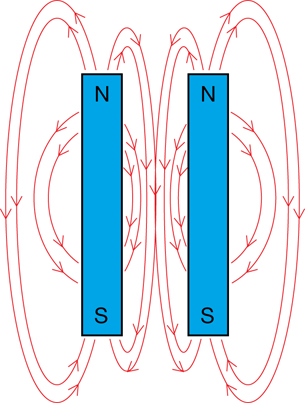Module 4
1. Module 4
1.4. Page 2
Module 4—Magnetic and Electric Fields in Nature and Technology
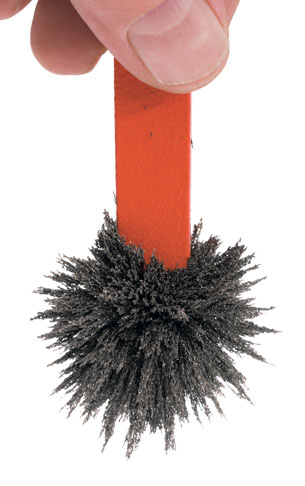
© Thomas Mounsey/shutterstock
 Explore
Explore
In the photo to the right, tiny iron filings cling to the end of a bar magnet. This should be no surprise since it is known that bar magnets can exert a force on other magnets and that some metals, such as iron, are easily attracted to bar magnets. This photo supports these observations. But it does more; the tiny bits of iron have collected along the lines of the magnetic field, hinting at its shape near the pole. As you will see in the Watch and Listen activities below, you can perform many other demonstrations to explore the nature of the magnetic field and reveal some of its properties.
magnetic field: a three-dimensional region of magnetic influence surrounding a magnet in which other magnets or magnetic substances are affected by magnetic forces
 Watch and Listen
Watch and Listen
The aurora is one of the greatest shows on Earth; it is caused by Earth’s magnetic field. But what is a magnetic field? As shown, a magnetic field can be observed by using bar magnets. Watch the video The Effect of Heat on Magnetism to see a magnetic field destroyed by heat and restored by cooling.
Magnetic Field of a Permanent Magnet
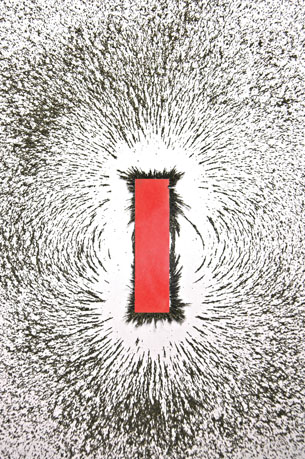
© Awe Inspiring Images/shutterstock
Each of the tiny filings of iron that are sprinkled near the bar magnet in the image above acts like a tiny compass. When the filings land they align themselves with the bar magnet’s magnetic field and reveal two dimensions of its shape. Like the electrical field between two oppositely charged point charges, the magnetic field has two poles, one at either end of the bar magnet. Like electric charges, like poles repel and unlike poles attract. The field is three-dimensional in nature, as observed in the interactive tutorial that follows.
 Try This
Try This
Note that the Try This activity is critical and presents important information that will be required later in this lesson and in the Module Assessment.
Explore the magnetic field surrounding a bar magnet using the interactive tutorial Magnetic Fields. Remember that magnetic “field lines” are mental constructs used to visualize the field; they are not physical entities. Be sure to notice the use of small compasses in the tutorial.
TR 1.
-
Draw a bar magnet, labelling the north and south poles. Sketch the magnetic field surrounding it, making sure your arrows point in the right direction. How is the direction of this field determined?
-
How does the density of the magnetic field lines relate to the field strength?

© Thomas Mounsey/shutterstock
When two bar magnets are placed near one another, the fields interact. The absence of filings between the poles in this photo is an indication of opposing magnetic fields. In this case, the two magnets are repelling one another. Perhaps you can see the field lines between the two magnets as almost perpendicular to the lengths of the magnets.
TR 2. Explore the magnetic field surrounding two bar magnets and how to represent magnetic fields in three dimensions using the interactive tutorial Two Magnets. What you draw on paper for a magnetic field depends on your point of view. Summarize the three different magnetic field representations.
Recall that in previous lessons the gravitational and electric fields were described by three-dimensional regions of influence. The magnetic field shares this similarity.
tesla: a unit of magnetic field strength (T) defined as one ![]() or one
or one ![]()
The magnetic field is a vector field and its direction is the direction the north (south-seeking) end of a compass will point when it is located in the magnetic field. Magnetic field strength is the magnitude of the magnetic field. Magnetic field strength is measured in a unit called the tesla (T). A tesla is defined as one ![]() or one
or one ![]() .
.
Magnetic fields tend to be stronger near the poles of magnets (or near Earth's poles). Earth's magnetic field strength in this region is about 6 × 10−5 T. A typical 10-g bar magnet has a magnetic field near its poles of about 2 × 10−2 T.
On occasion you may also see the strength of a magnetic field described using the term “flux.”
 Self-Check
Self-Check
SC 1. Each diagram shows two equal-strength bar magnets with test objects around them. Indicate the polarity of the bar magnets in each diagram.
![]()
a. ![]()
b. ![]()
c. 
d. 
SC 2. Each diagram shows two equal-strength bar magnets. Draw the magnetic field lines that would surround the pair of magnets.
a. ![]()
b. ![]()
c. 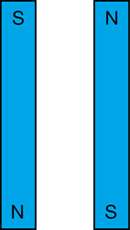
d. 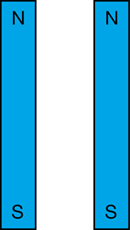
 Self-Check Answers
Self-Check Answers
SC 1. Contact your teacher if your answers vary significantly from the answers provided here.
a. ![]()
b. ![]()
c.
d. 
SC 2. Your field lines should look similar to those shown below.
a. 
b. 
c. 
d. 